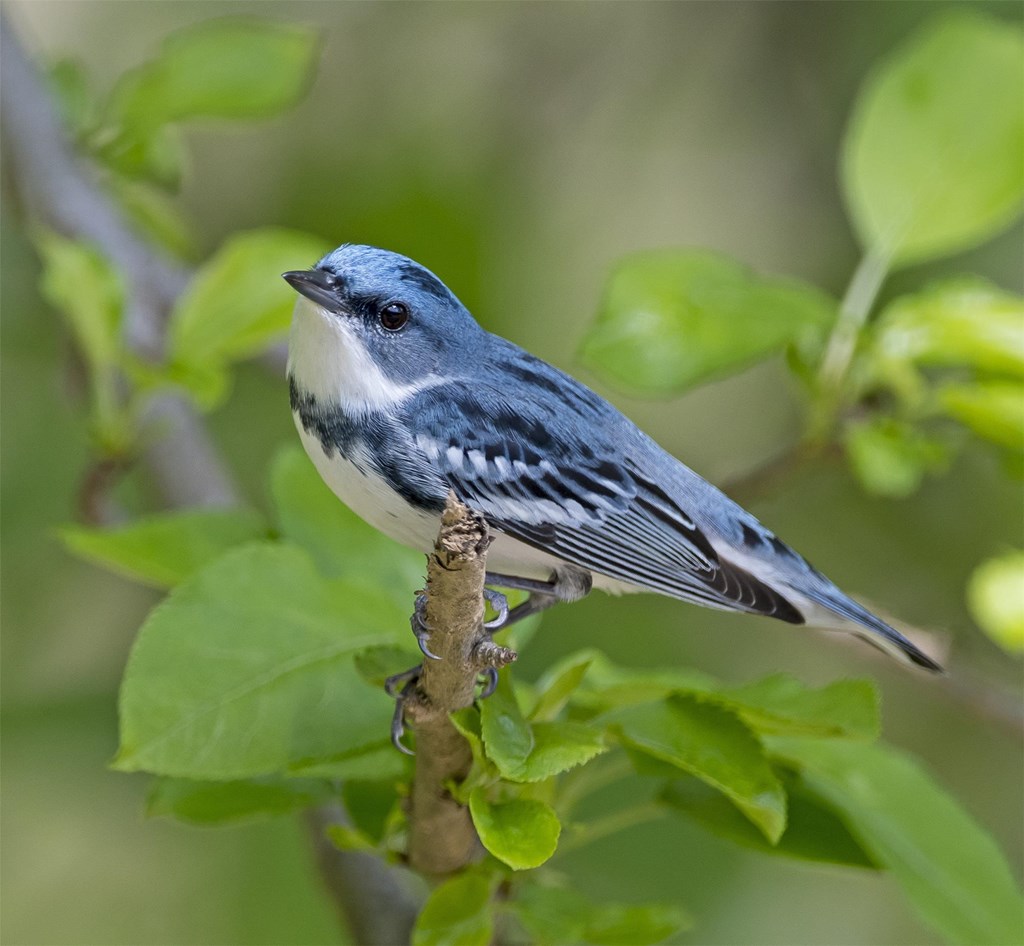Does the Cerulean Warbler Have the Blues?
Posted on in On the Mountain by Sean Grace, President

The cerulean warbler may just be one of the most rewarding wood warbler species to see, not only for the male’s beautiful cerulean blue coloration and striking white wing bars, but also because the species has declined by more than 70% since 1970. And, unlike many of our warbler species, they prefer to forage and nest high in the canopy, often at heights of more than 50 feet.
When searching for the cerulean, it is all about habitat. They prefer mature and mixed age class deciduous forest that are structurally diverse with canopy gaps, often on slopes or in riparian corridors. Although we have had cerulean warblers prospecting for new nesting territories on the Sanctuary, we have had no confirmed breeders. Given the birds’ penchant for both foraging and nesting high in the canopy, it is no wonder that learning their song can be extremely useful for finding them on breeding territories. To me, the song sounds like a fast version of "trees, trees, trees…trickety trees."
At Hawk Mountain Sanctuary, we not only care about the raptors that nest within and or fly over our forests but also are very interested in all the flora and fauna that call our 2,500-acre sanctuary home. That’s why land stewardship is part of our three-pronged mission that includes science and education and is part of the reason we decided to put the majority of our 2,500 acres of forested lands under conservation easement in 2018. That acreage has a comprehensive forest management plan that was informed by prior efforts to document and record all the wildlife and plants that are part of our Appalachian ecosystem.
In 2019, Hawk Mountain was approved by the National Resource Conservation Service (NRCS) to participate in the Cerulean Warbler Appalachian Forest Land Enhancement Project. The cerulean warbler, a species of national conservation concern, needs all the help it can get. Our participation in the NRCS program required us to identify and designate a piece of our property to support cerulean warblers where we would improve habitat to attract nesting cerulean warblers.
Structural diversity is extremely important for nesting avian fauna. A healthy forest includes a diverse understory of herbaceous plants, a mid-story of native shrubs, and a mature canopy with gaps created by the demise of mature trees. This structurally diverse forest provides better habitat with an abundance of native insects for foraging adults and densely vegetated areas for recently fledged birds to hide from predators. For a better idea of what native plant diversity should look like in a healthy forest, just visit our wonderful native plant garden that is fenced to keep out the wily white-tailed deer.
Our forests are in a constant state of change, and there are a variety of threats, both new and old, that need to be addressed to create suitable habitat for cerulean warblers. Some of those stressors that impact our forest include over-browsing by white-tailed deer and the encroachment of invasive plants. This results in large areas of the forest being heavily impacted by a monoculture of Japanese stilt grass on the forest floor and a heavily impacted shrub layer due to the browse of too many white-tailed deer. Combined, this creates abundant and long sight lanes in the forest that lack structural diversity. Seven years ago, there was a die back of nearly 60% of our chestnut oaks, when drought and four different insect defoliators stripped and killed this important tree species and impacted the forest yet again. You can see the skeletons of these former majestic trees all along the Kittatinny Ridge, especially in the fall once the leaves drop. Oaks are very important for early season Neotropical migrants, as the blooming of the flowers and leaf out coincides with the hatching of billions of insect eggs, often in the form of caterpillars, that feed the masses of migrating birds. This abundant food resource is why the birds leave their wintering grounds and why their nestlings can morph from a naked and blind nestling on day one to a juvenile that is as large as the parents in as soon as 11 days.
Our stewardship team, led by Todd Bauman, is actively working with NRCS to fence in part of a 30 acre plot we identified for cerulean warblers, to do some selective thinning to create additional canopy gaps, control invasive plants, and replant native trees. It is an interesting experiment that will likely show a dramatic increase in both plant and structural diversity within the fenced areas and a decrease in invasive plant species load. Invasive plants can be a curse because they generally do not support insect life and our native herbivores do not forage on them. Yet, these invasive plants often have a significant advantage that allow them to form near monocultures on our forest floors. One advantage is an earlier growing season start time. In early spring when you see all the beautiful green in the understory, nearly every species you are looking at is a non-native, invasive plant.
If you want to support this work, contact Mary Linkevich at 610-756-6000 ext 212 or [email protected].
Everything in our forests is linked whether we are aware of it or not. Today, we are applying best management practices to try and bring back the cerulean warbler and to learn more about how quickly native plants will recover in our patch of forest with the exclusion of white-tailed deer. Our hope is that in years to come, this site will be selected by the cerulean warbler as the habitat they prefer recovers and provides a suitable home.